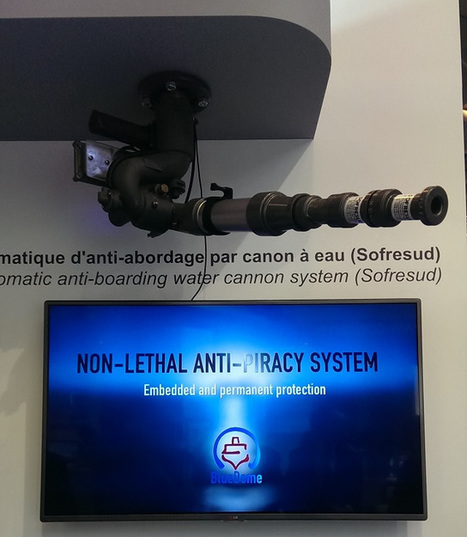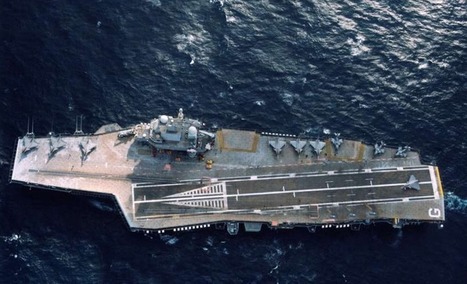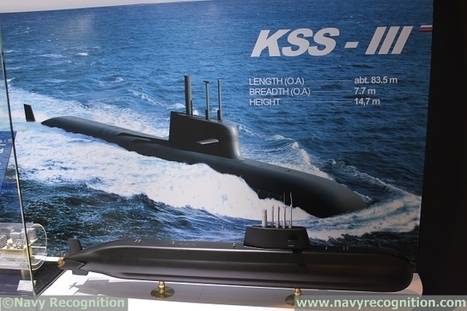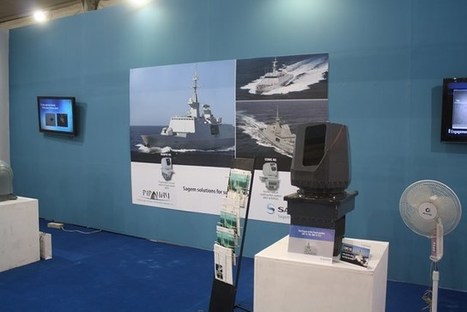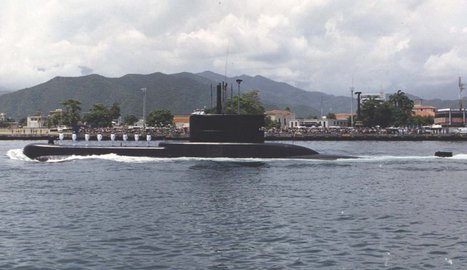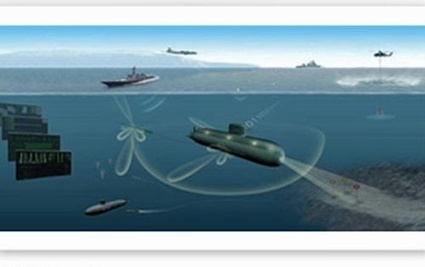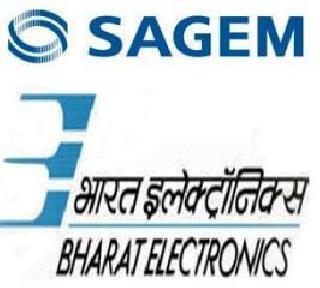 Your new post is loading...

|
Scooped by
Patrick H.
|
The Autoprotection consortium, led by Sagem (Safran), unveiled BlueDome at the Euromaritime trade show and exhibition from February 3-5, 2015 in Paris. BlueDome is a complete, fully integrated system designed to protect commercial ships against piracy. Autoprotection is a French consortium coordinated by Sagem and including major multinationals and specialized smaller businesses, all specialized in defense and security, and public entities: Amefo, Bureau Veritas, Eca Group, Ecole Nationale Supérieure Maritime, Lacroix, Sofresud, SeaOwl and Thales.
A graduated, non-lethal solution, BlueDome offers several successive barriers to protect ships during all attack phases. It includes the long-range detection of small craft, analysis of their behavior, identification using a day/night optronic turret, implementation of remote deterrents (light projectors, acoustic devices) and anti-boarding measures (water cannons, smoke grenades), as well as the ballistic protection of vulnerable areas and location of crew members. BlueDome automatically analyzes the situation and manages all systems and devices. Using an intuitive, user-friendly interface, it allows the crew to monitor the situation and approve recommended actions from a tablet. BlueDome also supports the remote operation of sensors and effectors from a secure area on the bridge (citadel), or anywhere else on the ship.
The development of BlueDome was co-funded by ADEME (the French environment and energy management agency), within the scope of France’s Investment in the Future initiative. It is supported by the French Maritime Cluster and incorporates recommendations from France’s top maritime piracy experts.

|
Rescooped by
Patrick H.
from Defense
|
L'unique porte avion français garde le cap! Sagem a entrepris cet été, en tant que co-contractant de DCNS, les travaux de remplacement des centrales inertielles du "Charles de Gaulle".
Les centrales mécaniques ont été remplacés par trois centrales Sigma 40DXP +. Une version réservée à la France et non disponible à l'export. Ces nouvelles centrales mettent en oeuvre des gyrolasers plus précis et moins couteux à l'entretien.
Les centrales inertielles du porte-avions sont essentielles car elles servent de référence à l'ensemble des systèmes opérés depuis le bâtiment dont les chasseurs (Deux centrales inertielles Sigma 95N sur le Rafale) et leur armement (Dont les bombes AASM ou encore le missile nucléaire ASMPA).
Le contrat pour la rénovation des centrales inertielles du "Charles De Gaulle" a été signé en 2013. Le système a déjà été en partie testé à la mer et devrait...
Via Valerie I.

|
Scooped by
Patrick H.
|
Navy Recognition learned from two separate sources who wished to remain anonymous that French defense companies Sagem and Thales would have been selected to provide sensor systems for South Korea’s Jangbogo III heavy diesel-electric submarine programme (KSS-III). Sagem will likely deliver its latest periscope system: the Series 30 Attack and Search Optronic Mast. According to Sagem, it is the most modern and complete optronic surveillance mast on the market. Its four simultaneously operational sensors, image processing and operating modes make it perfect for advanced detection of airborne or surface threats. It can equip both classic and nuclear submarines, whether new or retrofit units.
The Series 30 SMS is a non-penetrating mast designed for above-surface surveillance: navigation safety, surveillance, intelligence collection and self-protection combining electronic and optronic warfare. Compatible with a full range of electromagnetic antenna (GPS, ESM, early warning and communication), it includes a high-definition thermal imager as well as a high-definition camera, and can simultaneously accommodate a low-light level, anti-blooming camera and a laser range finder.
Its four optronic sensors, which can be used simultaneously to obtain panoramic scene captures in record time, are the fastest on the market. Known as the “Quick Look Round” feature, it enables panoramic or segment displays in separate, full resolution or compressed windows. This mode is available in addition to the conventional, live display of the different video channels. Details on the type (or types) of sonar to be provided by the underwater division of Thales (TUS) are confidential but Navy Recognition guess it is highly likely that KSS-III will at least be fitted with the Planar Flank Array Sonar (PFAS) passive long range sonar.
TUS PFAS enables full use of the large available space on the flanks of the submarine to install acoustic arrays of maximum aperture (length x height). The use of Adaptive Beamforming provides a very efficient rejection of the own ship noise and flow noise, which increases detection and classification performances even at high operational speed. Excellent bearing resolution/discrimination also enable increased Target Motion Analysis performance. A particular highlight of the TUS PFAS is its very reduced baffle which contributes to a large bearing coverage. Flank arrays feature no maneuverability constraints as compared to Clip-On Towed Arrays.
Both the new generation optronic masts and flank array sonars will give the new boats of the ROKN an important operational advantage in threats detection, identification and tracking. Same technology has already been selected by the French Navy for the future class of Barracuda nuclear-powered submarines. KSS-III is a conventional submarine project (SSK).
The original design of the submarine includes 6 VLS (vertical launch system) tubes. They would accomodate a future cruise missile in development by LIG Nex1 while the launchers would be provided by Doosan. It was announced earlier this year that Spanish company INDRA was selected to provide its electronic defense system (ESM) PEGASO and Babcock of the UK would design and manufacture the Weapon Handling System for the submarines.
Under the Jangbogo III programme boat one is due to be handed over to the Republic of Korea Navy at the end of 2020, and boat two at the end of 2022.

|
Scooped by
Patrick H.
|
New Delhi, Defexpo India, February 7th, 2014. The French defense procurement agency DGA (Direction générale de l’armement) has announced its choice of Sagem (Safran) to modernize the optronic systems on four Horizon and Cassard class air defense frigates in the French navy. These ships will be equipped with Sagem’s EOMS-NG, New-Generation Electro-Optical Multifunction System. Developed and produced by Sagem, the EOMS-NG is a high-performance, third-generation optronic (electro-optical) system that provides panoramic infrared surveillance, reconnaissance, identification and tracking. The EOMS-NG operates day or night, at sea or in coastal areas, and against all types of threat, whether surface, air or missiles, and conventional or asymmetric. EOMS-NG systems are controlled from Sagem consoles located at the operations center and the close air defense bridge.
The program also provides for complete maintenance of all systems delivered over a period of three years, including spares and the production of a simulation system to train operators at the Naval Instruction Center in Saint-Mandrier.
The EOMS-NG systems will be produced by Sagem’s Dijon plant, for delivery from summer 2014 to the end of 2015. Each of the four frigates will be equipped with a system.
Sagem has logged more than 40 years of experience in developing and producing optronic systems for both surface vessels and submarines. The EOMS-NG has been chosen for the Floréal and OPV Adroit class frigates made by DCNS, and Baynunah corvettes for the United Arab Emirates. The VAMPIR-NG, an infrared surveillance version of the EOMS-NG, will be used on Anzac class frigates for Australia and New Zealand, and Australia’s aircraft carriers and AWD air warfare destroyers.
|

|
Scooped by
Patrick H.
|
AB Sábalo (S31)
Sagem (part of the Safran group) is currently negotiating with the Venezuelan Navy (Armada Bolivariana de Venezuela) and the country's state-owned shipbuilder DIANCA (Diques y Astilleros Nacionales Compañía Anónima) over the installation of Sagem's Sigma 40XP inertial navigation system on Venezuela's two Type 209/1300 diesel-electric submarines (SSKs), AB Sábalo (S31) and AB Caribe (S32). IHS Jane's understands that a contract could be signed before the end of 2014. Produced at the company's Montluçon plant, the Sigma 40XP system develops and transmits heading, roll, and pitch; latitude, longitude, and depth; and horizontal and vertical linear velocities. The Sigma 40XP system can be found already onboard the submarines of a number of navies, including Australia, Chile, Ecuador, France, India, Norway, South Korea, and Vietnam.

|
Scooped by
Patrick H.
|
Euronaval 2014 Paris October, 27 2014 - Following an international request for proposals, Sagem (Safran) has signed a contract with Daewoo Shipbuilding & Marine Engineering Co. Ltd (DSME) of South Korea, to supply the optronic surveillance masts for the country’s new submarines.
The selection of Sagem was made by a commission comprising members from the South Korean navy, DAPA (Defense Acquisition Program Administration), ADD (Agency for Defense Development) and DSME. The decisive factors in this decision were the best world-class competitiveness and performance level offered by Sagem’s optronic masts, especially in terms of image resolution and processing, and their easy integration in the ship’s combat suite.
This latest contract emphasizes the outstanding collaboration between South Korean industry and Sagem. Sagem’s new generation of optronic masts, which do not penetrate the thick hull, feature low-observability and radar stealth. In addition to the optronic (electro-optical) sensors from Sagem, they also include a signal intelligence system, and an infrared system for discreet communications.
The future optronic surveillance mast is derived from Sagem’s Series 30 masts already in production for the Scorpène class submarines built by French naval shipyard DCNS for international markets, and for the future Suffren class nuclear attack submarines in the French navy’s Barracuda program.
Sagem develops and produces for its partners a complete family of optronic masts and attack periscopes, electronic warfare equipment and radars for submarines.
The masts will be integrated at Sagem’s plant in Dijon and the infrared imagers in Poitiers.

|
Scooped by
Patrick H.
|
Sagem (Groupe Safran) a signé un protocole d'accord avec la société indienne Bharat Electronics Limited pour explorer une collaboration dans le domaine de la production et de la fourniture d'équipements de navigation et d'optronique pour la marine indienne. Le projet a été paraphé lors du salon Defexpo India de New Delhi. Il court sur deux ans, reconductibles d'autant si nécessaire. New Delhi:Bangalore based Bharat Electronics Limited (BEL),a company owned by the Ministry of Defence (MoD) has signed a Memorandum of Understanding (MoU) with Sagem Défense Sécurité, France, to explore co-operation in the production and supply of Navigational sensors like periscope, Inertial Navigational System and optronic mast to the Indian Navy for its various platforms under consideration for future induction. The MoU was signed at the BEL stall at DEFEXPO -2014 here by PC Jain, Director Marketing, BEL, and Bruno Even, CEO, Sagem, France. Sagem is company of the French Safran group. SK Sharma, Chairman and Managing Director, BEL, Joel Berkoukchi, COO, Director, Avionics Division, Sagem, France and Chandrasekhar S, General Manager (Naval Systems), BEL, were also present at the signing ceremony. The Indian Navy has ambitious plans of inducting ships and submarines into the service in the near future. Accordingly, the ship and submarine construction programme has been approved by the Government. Naval platforms have large-scale requirement of sensors such as SIGMA–40, Ring Laser Gyro, Optronic mast, Attack Periscope and Radar Mast for submarines. Sagem Défense Sécurité has the technology and expertise in the manufacture of these sensors. BEL is the leader in the manufacture and supply of defence electronics for the Indian Armed Forces. BEL and Sagem coming together to co-operate in the field of navigational sensors for ships and submarines will help in meeting the needs of the Indian Navy. The MoU will help in understanding and absorbing the critical technology adopted in these sensors for use in future induction platforms of the Navy. The MoU will facilitate BEL and Sagem to work together for 24 months and if considered necessary, the same can be extended to a further period agreeable to both the companies.
|



 Your new post is loading...
Your new post is loading...

